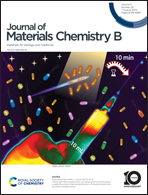Agar/gelatin hydro-film containing EGF and Aloe vera for effective wound healing†
Abstract
In the current study, we produced a hydro-film dressing for the treatment of chronic wounds. The hydro-film structure was composed of gelatin cross-linked with citric acid, agar and Aloe vera extract (AV); additionally epidermal growth factor (EGF) was loaded to promote wound healing. Due to the excellent hydrogel-forming ability of gelatin, the obtained hydro-film was able to swell 884 ± 36% of its dry weight, which could help controlling wound moisture. To improve gelatin mechanical properties, polymer chains were cross-linked with citric acid and agar, reaching an ultimate tensile strength that was in the highest range of human skin. In addition, it showed a slow degradation profile that resulted in a remaining weight of 28 ± 8% at day 28. Regarding, biological activity, the addition of AV and citric acid provided the ability to reduce human macrophage activation, which could help reverse the permanent inflammatory state of chronic wounds. Moreover, loaded EGF, together with the structural AV of the hydro-film, promoted human keratinocyte and fibroblast migration, respectively. Furthermore, the hydro-films presented excellent fibroblast adhesiveness, so they could be useful as provisional matrices for cell migration. Accordingly, these hydro-films showed suitable physicochemical characteristics and biological activity for chronic wound healing applications.

- This article is part of the themed collection: #MyFirstJMCB


 Please wait while we load your content...
Please wait while we load your content...